For me, there is nothing more special than paddling the canyons of the Rio Grande with a group of close friends who enjoy exploring the wonders of nature on multiday canoe camping trips. On February 24, 2006, members of Dallas Downriver Club, Adventure Club San Antonio and Alamo City Rivermen departed Dallas and San Antonio for a rendezvous off FM 170 between Lajitas and Presidio to begin an 8-day journey along the Texas-Mexico border through Colorado, Santa Elena and Mariscal Canyons that was very special in every way. Our group included Thomas Taylor, Steve Crowe and myself from DDRC, Dirk Davidek and Scott Dillon from ACSA, and Gary Tupa and Zoltan Mraz from ACR.
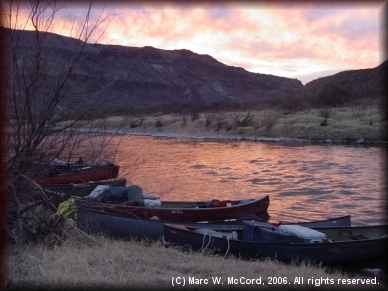 After a long day of driving and a late start from Dallas, Tom, Steve and I arrived at the put-in above Colorado Canyon around 4 AM on Saturday morning, February 25. The rest of the group had arrived much earlier, and was sacked out in their tents, snoring to beat 60! Wild animals were driven away by the noise these guys were making! After sleeping for about 3 hours I awoke, then rousted Tom and Steve from their deep slumbers. Scott, Zoltan, Gary and Dirk were already awake and making coffee. We struck camp, then sent the drivers to Far Flung Outdoor Center with whom we had contracted for a shuttle. We left cars at Far Flung, and their driver returned our drivers to the put-in above Colorado Canyon where he was amazed at the amount of gear we had with us. What he did not realize was that we had about one third of our supplies still in our vehicles because we would not need it until after we exited Santa Elena Canyon the following Thursday afternoon.
After a long day of driving and a late start from Dallas, Tom, Steve and I arrived at the put-in above Colorado Canyon around 4 AM on Saturday morning, February 25. The rest of the group had arrived much earlier, and was sacked out in their tents, snoring to beat 60! Wild animals were driven away by the noise these guys were making! After sleeping for about 3 hours I awoke, then rousted Tom and Steve from their deep slumbers. Scott, Zoltan, Gary and Dirk were already awake and making coffee. We struck camp, then sent the drivers to Far Flung Outdoor Center with whom we had contracted for a shuttle. We left cars at Far Flung, and their driver returned our drivers to the put-in above Colorado Canyon where he was amazed at the amount of gear we had with us. What he did not realize was that we had about one third of our supplies still in our vehicles because we would not need it until after we exited Santa Elena Canyon the following Thursday afternoon.
Because you never know what the Rio Grande and Big Bend will throw at you we were prepared for hot, cold, wet and dry conditions. Packing for such possibilities requires carrying more gear than normal, but the alternative is unacceptable in a remote desert wilderness where outside assistance is a day or more away. Thanks to the complement of Kokatat paddling clothing I have, being prepared for the conditions we encountered was a piece of cake. As it turned out, all we really needed was clothing for hot and dry conditions, so I ended up paddling in shortsleeve shirts and paddling shorts. Others wore longsleeves and long pants to protect against sunburn.
By the time we began our trip it was already late in the day. Our plan was to paddle a few miles, then find a Mexican side campsite inside Colorado Canyon where we would stay our first night on the river. We paddled about 4 miles, running the first set of rapids without much difficulty, though the water was low and we occasionally had to drag our loaded boats through spots where we could not paddle. We were hoping for a rise in the river from some of the heavy rains that fell on us all the way down to Big Bend, but it never happened. The area was bone-dry and showed no signs of recent rainfall anywhere near the river. Still, the flow was adequate for great paddling except in a few rapids. We made camp, then started cooking an improvised dinner of sausage, red beans and rice and pan-fried potatoes, then dined in style along this big, muddy ditch that separates the nations of Texas and Mexico. We had to rely on extra food we had with us since our initial plan called for starting the trip on Sunday, and we ate well!
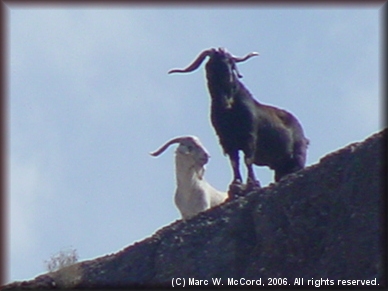 We arose early on Sunday morning, prepared a breakfast of bacon, eggs and English muffins, then struck camp and headed out down the river. We were thrilled to see bighorn sheep on the mountaintops above the river high over our heads, watching us as we paddled down the river and probably wondering why a group of guys would be running the river in loaded boats in such low-water conditions. Or, they may have just been looking for food. Colorado Canyon features most the largest rapids (Class II to III) and steepest gradient of the river above the Lower Canyons, and the volcanic structure of the mountains surrounding the river contribute to both the scenery and the technical difficulty of paddling the Rio Grande.
We arose early on Sunday morning, prepared a breakfast of bacon, eggs and English muffins, then struck camp and headed out down the river. We were thrilled to see bighorn sheep on the mountaintops above the river high over our heads, watching us as we paddled down the river and probably wondering why a group of guys would be running the river in loaded boats in such low-water conditions. Or, they may have just been looking for food. Colorado Canyon features most the largest rapids (Class II to III) and steepest gradient of the river above the Lower Canyons, and the volcanic structure of the mountains surrounding the river contribute to both the scenery and the technical difficulty of paddling the Rio Grande.
On Sunday night, we camped along the Mexican side of the river where we prepared a fine dinner of grilled chicken and vegetables (yellow squash, zucchini, onion, bell peppers, new potatoes, carrots and celery) with wheat rolls, then settled in to tell lies under a dark sky filled with billions of stars. We observed three satellites passing overhead and saw some brilliant and long-lasting shooting stars with enormous tails that wowed us all. While our daytime temperatures were soaring into the mid-to-upper 90's, nights were cooler with lows in the upper 40's to lower 50's - not half bad for the middle of the winter! We laughed about all those people "up north" who are suffering cabin fever due to snow, ice and frozen rivers that leave them no chance to go outside and play in their boats. We were suffering no such misfortunes.
Monday morning began with a delicious breakfast of burritos made from scrambled eggs, sausage, bell pepper, onion, potatoes, grated cheese and hot salsa rolled up in large, flour tortillas. We were, afterall, in Mexico! After breaking camp and loading boats we began our journey toward Santa Elena Canyon, stopping at Lajitas to resupply with ice, Dr Pepper and some snacks to add to our already bulging food supplies. We paddled down to a desert campsite about 4 miles above the entrance to Santa Elena, then made camp for our third night on the river. The rapids we encountered were much like what we had run above, and we occasionally had to line or drag our boats through the low water to get downriver. We spent another night under a cloudless sky filled with stars set against a backdrop of open desert. We were right on schedule for our planned position relative to our intended take-out below Santa Elena Canyon on Thursday afternoon.
We arose early on Tuesday morning and planned a relaxing, short paddle into the entrance of Santa Elena Canyon, where we intended to layover on Wednesday before paddling out on Thursday afternoon. We paddled through Entrance Rapid, a Class II boulder garden that required a little tight maneuvering due to the low water, and were awe-stricken by the beauty and grandeur of those gigantic mountains that form this gorgeous canyon in the Big Bend of Texas. No matter how many times you come here it is always a joy to paddle into this tight canyon where the walls rise right out of the river and tower 1,200-1,500 feet overhead. The colors created by the position of sunlight and shadows are an ever-changing pallet of natural scenery that no human could create or duplicate. We found a suitable Mexican side campsite, set up our tents, then started getting ready to prepare and enjoy a dinner of USDA heavy-aged beef steaks, baked potatoes and grilled vegetables. In spite of the heat and the "hard" paddling, we might have actually been gaining weight on this trip, though our canoes were starting to get a little lighter as we consumed mass quantities of food and beverages. Tuesday night in the canyon was truly spectacular - we could see the mountains silhouetted by the faint moonlight of a waxing orb that had just passed the new moon phase. This is nearly as close to heaven as it gets. All that was missing were some hot wimmin to keep us company!
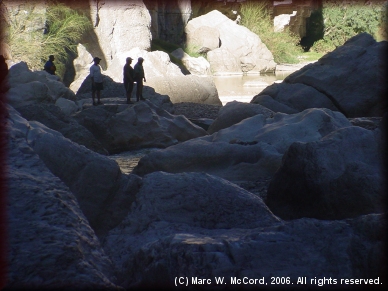 Our initial plan was to layover on Wednesday and just explore side canyons, relax, take a million photographs (we accomplished that feat!) and enjoy a day in a gorgeous, natural wonder that few people will ever see because the only way in is in a canoe, kayak or raft. Some in our group wanted to make sure that we arrived at the Santa Elena take-out ahead of our shuttle drivers on Thursday, so we broke camp early on Wednesday, then paddled down through Rockslide Rapid (Class II to IV, depending upon flow conditions) to our Wednesday night campsite at Fern Canyon just below Arch Canyon, two Mexican side canyons that cut into Santa Elena a few miles above its mouth. The photo at the right depicts us standing on the boulders that form Rockslide rapid, scouting the best line to get through them to our intended campsite for Wednesday night. In low-water conditions the maneuvering is tricky, but not particularly difficult. In high-water conditions this can be a monster obstruction that is capable of breaking bones and boats in a heartbeat.
Our initial plan was to layover on Wednesday and just explore side canyons, relax, take a million photographs (we accomplished that feat!) and enjoy a day in a gorgeous, natural wonder that few people will ever see because the only way in is in a canoe, kayak or raft. Some in our group wanted to make sure that we arrived at the Santa Elena take-out ahead of our shuttle drivers on Thursday, so we broke camp early on Wednesday, then paddled down through Rockslide Rapid (Class II to IV, depending upon flow conditions) to our Wednesday night campsite at Fern Canyon just below Arch Canyon, two Mexican side canyons that cut into Santa Elena a few miles above its mouth. The photo at the right depicts us standing on the boulders that form Rockslide rapid, scouting the best line to get through them to our intended campsite for Wednesday night. In low-water conditions the maneuvering is tricky, but not particularly difficult. In high-water conditions this can be a monster obstruction that is capable of breaking bones and boats in a heartbeat.
We safely navigated Rockslide, then paddled on downriver past Arch Canyon to a perfect campsite on the Mexican side at Fern Canyon. It was here that we encountered our first sighting of humans (other than a Mexican caballero sitting on his horse high on a cliff above Colorado Canyon). Two of the Terlingua outfitters (Big Bend River Tours and Far Flung Outdoor Center) were putting people in canoes on the river at the mouth of the canyon for day trips up the river and back down again. None of the paddlers we saw stopped where we were other than a couple from Kansas who hiked up Fern Canyon for lunch, then left again. Could it possibly have something to do with our having been on the river for five days without bathing? Nah! We smelled like roses and lillies.
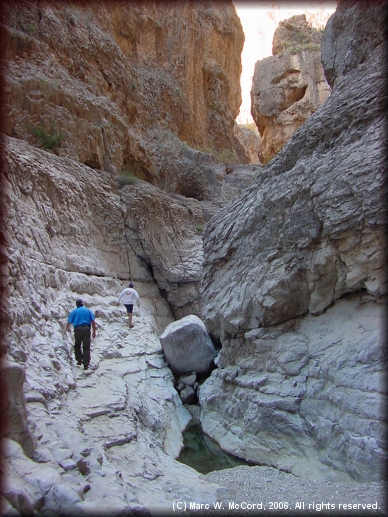 After setting up our campsite for the last night in Santa Elena Canyon Dirk, Scott, Gary and I hiked up Fern Canyon as far as we could go without doing some serious mountain climbing. The photo at the left shows us working our way up the canyon amid huge limestone boulders that were sometimes slick, especially if we got our feet into the small stream of water that was trickling out of the canyon down toward the river. Fern Canyon is never more than perhaps 100 feet wide, and often much narrower than that, but its native beauty is awesome. House-size boulders have, over the years, fallen from their lofty perches to rest on solid rock below, often right on top of the small stream of water we encountered there. We found a pool of very cool mountain water where Steve later took a bath, and though he looked and smelled better than the rest of us he said that the water was really cold.
After setting up our campsite for the last night in Santa Elena Canyon Dirk, Scott, Gary and I hiked up Fern Canyon as far as we could go without doing some serious mountain climbing. The photo at the left shows us working our way up the canyon amid huge limestone boulders that were sometimes slick, especially if we got our feet into the small stream of water that was trickling out of the canyon down toward the river. Fern Canyon is never more than perhaps 100 feet wide, and often much narrower than that, but its native beauty is awesome. House-size boulders have, over the years, fallen from their lofty perches to rest on solid rock below, often right on top of the small stream of water we encountered there. We found a pool of very cool mountain water where Steve later took a bath, and though he looked and smelled better than the rest of us he said that the water was really cold.
It would have been great to have arrived at Fern Canyon the day before and had more time to explore it. Our trek only went a short distance, but with climbing shoes and more time we could have found splendid scenery that lay just beyond our eyesight. The hike into Fern Canyon was physically demanding for us older guys who spend more time on computers than in gyms or on hiking trails. I am convinced that there are some remarkable sights yet to be discovered by us further up that canyon, and so we have an incentive to return to Santa Elena, as if any additional prodding would be necessary. It would be very special to see the color changes as the sun rose, soared overhead, then set upon that vast cleft in the limestone walls of Santa Elena. Surprisingly, we saw no signs of animal life in Fern Canyon. To me, it looked like a perfect place to see mountain lions and possible black bears.
We camped that night and enjoyed a meal of Cajun sausage, pan-fried potatoes and leftover vegetables from a meal the day before. We were right on schedule, as our supplies were quickly dwindling. We had planned and coordinated our trip perfectly, and we all had lighter boats as we prepared to leave Santa Elena Canyon late Thursday morning. The setting sun cast a beautiful glow all over the canyon and the colors were dazzling. Nightfall brought another spectacular lightshow of stars. As the moon rose in the sky its direct path to us was blocked by the mountains, but we were treated to a scene of moonlight on the canyon walls starting many feet above the canyon floor. It was simply grand being here in this gorgeous canyon among friends with whom I had paddled on many trips over several years. I think that we all agree that we must return here as soon as possible, though it might have to wait until after another Lower Canyons trip, which we hope to do later this year at either Thanksgiving or Christmas.
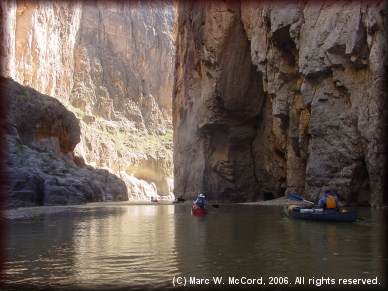 After a breakfast of burritos we struck camp and leisurely loaded our boats for our departure from Santa Elena Canyon. We were just a few short miles from our take-out and had a 2 PM rendezvous with our Far Flung Outdoor Center shuttle drivers. Around 11:15 Am, we began our slow paddle to the take-out about 0.9 miles below the mouth of the canyon and the confluence of Terlingua Creek. At the mouth of the canyon we began encountering many landlubber touristas who were walking the Texas side along an observation path created by the National Park Service to allow viewing up into the canyon. While not quite as grand as seeing it from a canoe, the view at the mouth looking into the canyon is quite scenic, and this is a favorite destination for visitors to Big Bend National Park.
After a breakfast of burritos we struck camp and leisurely loaded our boats for our departure from Santa Elena Canyon. We were just a few short miles from our take-out and had a 2 PM rendezvous with our Far Flung Outdoor Center shuttle drivers. Around 11:15 Am, we began our slow paddle to the take-out about 0.9 miles below the mouth of the canyon and the confluence of Terlingua Creek. At the mouth of the canyon we began encountering many landlubber touristas who were walking the Texas side along an observation path created by the National Park Service to allow viewing up into the canyon. While not quite as grand as seeing it from a canoe, the view at the mouth looking into the canyon is quite scenic, and this is a favorite destination for visitors to Big Bend National Park.
We arrived at our take-out about 90 minutes ahead of our shuttle drivers, so we had time to unload the boats, suck down some drinks, snack a little and take a few photos before they arrived with our vehicles and trailer. For many paddlers this would have been the end of the line, but we still had two more days of paddling Mariscal Canyon with an additional group of ACSA members whom we were meeting that night in Chisos Basin, but not before returning to Far Flung Outdoor Center to retrieve our extra ice chests full of food and beverages, find a place to shower and get the bolts we needed for repairing a couple of broken canoe seats (probably caused by all the excellent meals we enjoyed on this trip.)
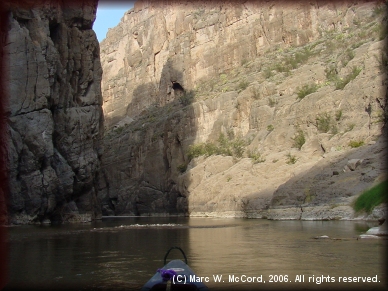 Upon making ourselves presentable we drove to Chisos Basin in Big Bend National Park where we camped Thursday night. We were joined there by nine other paddlers, seven of whom were ACSA members and two others who heard about our trip and wanted to go. The new group included Lindsay Stevens, Sean Stubbs, Caroline Anderson, Heather Glass, Charman Barry, John Berry and Tom Williems from ACSA, as well as Joline Moore from the Saturday Paddlers and George Lackey from San Angelo. The Newbies had to fend for themselves on Thursday night, but those who started the trip at Colorado Canyon dined on barbeque chicken leg quarters with potato salad, barbeque baked beans and wheat rolls. Fortunately, we were the only occupants of the group campground that night because we overflowed into three additional spaces beyond what we had reserved. The big sky of the basin gave us an excellent view of the stars as we sat in the bowl of what is probably an inactive (we hope) volcano.
Upon making ourselves presentable we drove to Chisos Basin in Big Bend National Park where we camped Thursday night. We were joined there by nine other paddlers, seven of whom were ACSA members and two others who heard about our trip and wanted to go. The new group included Lindsay Stevens, Sean Stubbs, Caroline Anderson, Heather Glass, Charman Barry, John Berry and Tom Williems from ACSA, as well as Joline Moore from the Saturday Paddlers and George Lackey from San Angelo. The Newbies had to fend for themselves on Thursday night, but those who started the trip at Colorado Canyon dined on barbeque chicken leg quarters with potato salad, barbeque baked beans and wheat rolls. Fortunately, we were the only occupants of the group campground that night because we overflowed into three additional spaces beyond what we had reserved. The big sky of the basin gave us an excellent view of the stars as we sat in the bowl of what is probably an inactive (we hope) volcano.
On Friday morning, we awoke at about 6 AM, and began preparing for the long shuttle through open desert to the Talley Access at the top of Mariscal Canyon. Since we were running our own shuttle we had to leave early, and we departed Chisos Basin around 9:30 AM for the 3-hour drive to Talley. Stopping at Rio Grande Village, we dropped off vehicles that could not traverse the desert, restocked our ice supply, loaded everything onto the four vehicles being used for the shuttle, then headed out to begin our 2-day Mariscal Canyon trip of about 11 miles. Everything progressed smoothly according to our plan, though we were a little later getting on the river than we had anticipated. It was not a problem because we were just going a few miles into the canyon before stopping to camp for the night. After dropping our boats, gear and everybody who was not driving a shuttle vehicle at Talley, the drivers departed for the Solis Access take-out and left all but one vehicle there, using the remaining vehicle to return to Talley where the rest of us were loading boats and getting ready to go.
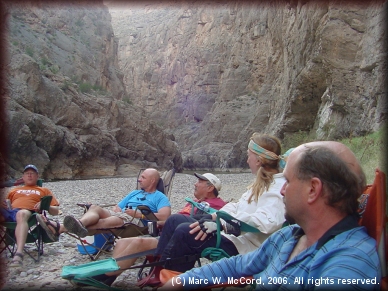 The only major obstacle in Mariscal Canyon is the class II to III+ Tight Squeeze Rapid, which is really just a huge boulder field very similar to Rockslide in Santa Elena Canyon. Apparently, rains since we were there last year had radically altered the landscape, and upon arriving at our Mexican side campsite we decided to paddle about a quarter mile back upriver to a Texas side campsite that was larger and more accommodating. Once situated at our overnight campsite we began preparing a dinner of grilled whitefish fillets and vegetables that had everybody coming back for seconds...and thirds. There were no leftovers. We sat around the campsite and gazed in awe at the beauty of Mariscal Canyon in the fading sunlight of our last night on the river.
The only major obstacle in Mariscal Canyon is the class II to III+ Tight Squeeze Rapid, which is really just a huge boulder field very similar to Rockslide in Santa Elena Canyon. Apparently, rains since we were there last year had radically altered the landscape, and upon arriving at our Mexican side campsite we decided to paddle about a quarter mile back upriver to a Texas side campsite that was larger and more accommodating. Once situated at our overnight campsite we began preparing a dinner of grilled whitefish fillets and vegetables that had everybody coming back for seconds...and thirds. There were no leftovers. We sat around the campsite and gazed in awe at the beauty of Mariscal Canyon in the fading sunlight of our last night on the river.
Saturday was our eighth day on the river for those of us who started at Colorado Canyon, and we were sad to see our trip approaching its end. We had a leisurely morning, sleeping later than on most mornings before getting about the tasks of preparing breakfast and striking camp. We still had a 2-hour shuttle back to Rio Grande Village awaiting us after we reached the Solis Access take-out. We loaded our boats, then began our final 7 miles of the trip, working our way carefully through Tight Squeeze, which it really was in low water, then enjoying the scenery as we approached the end of Mariscal Canyon. Zoltan Mraz, Gary Tupa, Scott Dillon, Steve Crowe, Tom Taylor and myself had recently paddled the San Marcos River on the 19th Annual Alamo City Rivermen Freeze Trip. Tom, Steve, Dirk and I paddled Boquillas Canyon together with a Dallas Downriver Club group last Thanksgiving. This was my first trip with the others, most of whom were new ACSA members.
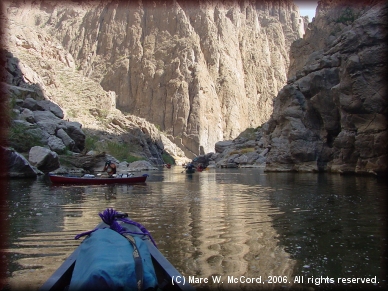 Upon arrival at Solis, we loaded boats and gear onto our trailer and second shuttle vehicle while Gary returned Dirk to Talley to retrieve his vehicle. Upon their return we loaded the two remaining vehicles, then set out for Rio Grande Village where we set up camp for Saturday night and began cooking a homemade beef stew that everybody devoured as if they had not eaten in a month. Apparently, it was appealling to everybody in the group. We were joined by two other ACSA new members, Michelle and Rachel, who spent Friday and Saturday biking the roads of Big Bend while the rest of us paddled. Most of the group never even set up tents, preferring instead to just sleep on the ground under the stars. In anticipation of possible javelina visits, I set up my tent, but left off the rainfly so I could view the stars. The peccaries never showed up.
Upon arrival at Solis, we loaded boats and gear onto our trailer and second shuttle vehicle while Gary returned Dirk to Talley to retrieve his vehicle. Upon their return we loaded the two remaining vehicles, then set out for Rio Grande Village where we set up camp for Saturday night and began cooking a homemade beef stew that everybody devoured as if they had not eaten in a month. Apparently, it was appealling to everybody in the group. We were joined by two other ACSA new members, Michelle and Rachel, who spent Friday and Saturday biking the roads of Big Bend while the rest of us paddled. Most of the group never even set up tents, preferring instead to just sleep on the ground under the stars. In anticipation of possible javelina visits, I set up my tent, but left off the rainfly so I could view the stars. The peccaries never showed up.
Sunday morning brought the end of our trip. We struck camp, drove to Chisos Basin and had breakfast at the lodge there, then bade farewell to each other before departing for our respective destinations. Another succesful and exciting trip was on the books, and I think that we all hated to have to return home. Those of us who are Rio Grande veterans never fail to be enticed to return, and hopefully those who had never been here before caught the same fewer. I am cerain that several of us will be paddling the Rio Grande again before the end of this year if there is adequate water for a good trip. I am happy to have been on this trip with so many good people, and to have shared a moment in their lives. As diverse as our various backgrounds are, we all have one thing in common - we love and appreciate the infinite beauty of nature and the thrill of paddling and camping along a gem of a river - the Rio Grande!


